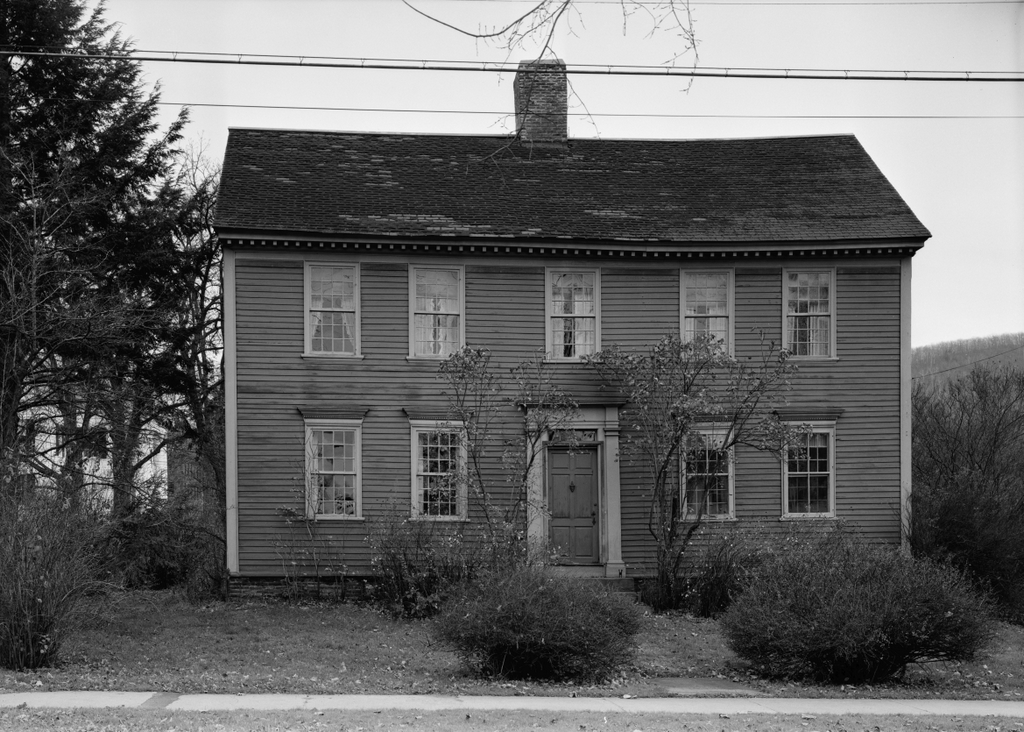The Wells-Thorn House at the corner of Old Main Street and Memorial Street in Deerfield, in November 1959. Image courtesy of the Library of Congress, Historic American Buildings Survey Collection.
The house in 2023:
This house was built around 1747 as the home of Ebenezer Wells (1691-1758) and his wife Abigail Barnard (1691-1772). They had no children, but their household here included at least two enslaved people: Lucy Terry (c.1733-1821) and Caesar (baptized 1734). Lucy is best remembered today for being the author of the poem “Bars Fight,” earliest known work of African American literature. The poem memorializes those who were killed during a 1746 Native American raid on a group of families that were working in the meadows, or “bars,” near the village. It seems unclear when the poem was first put down on paper, but it remained an oral tradition for more than a century before it was published by Josiah Gilbert Holland in his 1855 book History of Western Massachusetts. According to Holland, the poem reads:
August ’twas the twenty-fifth,
Seventeen hundred forty-six;
The Indians did in ambush lay,
Some very valient men to slay,
The names of whom I’ll not leave out.
Samuel Allen like a hero fout,
And though he was so brave and bold,
His face no more shall we behold.
Eleazer Hawks was killed outright,
Before he had time to fight,—
Before he did the Indians see,
Was shot and killed immediately.
Oliver Amsden he was slain,
Which caused his friends much grief and pain.
Simeon Amsden they found dead,
Not many rods distant from his head.
Adonijah Gillett we do hear
Did lose his life which was so dear.
John Sadler fled across the water,
And thus escaped the dreadful slaughter.
Eunice Allen see the Indians coming,
And hopes to save herself by running,
And had not her petticoats stopped her,
The awful creatures had not catched her,
Nor tommy hawked her on her head,
And left her on the ground for dead.
Young Samuel Allen, Oh lack-a-day!
Was taken and carried to Canada.
Because the raid happened only a year or so before this house was built, it is possible that Lucy was living in the house when she composed the poem. But either way, she appears to have lived here until at least 1756, when she married Abijah Prince, a free Black man who was from Curaçao. An article written by the Pocumtuck Valley Memorial Association suggests that the wedding may have occurred here in this house, as was customary for the time. Lucy appears to have gained her freedom around this time, and she and Abijah lived on the eastern part of the Wells property early in their marriage. By 1764, they had moved to Guilford, Vermont, where they owned land. Abijah died in 1794, and Lucy eventually moved to Sunderland, Vermont, where she died in 1821.
In the meantime, Ebenezer and Abigail Wells lived here until Ebenezer’s death in 1758. He left the house to his nephew Ebenezer Wells (1730-1783), and Abigail subsequently moved to Northampton. The younger Ebenezer lived here for the rest of his life, as did his wife Mercy Bardwell (1737-1801). Their son David then inherited the property, but sold it to lawyer Hezekiah W. Strong (1768-1848).
Strong repainted the house to a bright robins egg blue color, evidently in the hopes of drawing attention to his law practice. However, he only remained in town for a few years, and he sold it in 1804 to John Dwight. The house was later owned by the Ware family for most of the 19th century, and then in 1905 it was sold to Edwin (1874-1920) and Luanna (1874-1965) Thorn. Edwin was a physician, but both he and Luanna were involved in the Deerfield Arts & Crafts movement. They produced colonial-inspired household goods, including furniture and textiles, and they sold them out of a shop here in their home.
Edwin Thorn died in 1920, but Luanna outlived him by many decades. She was still living in the house when the top photo was taken in 1959, as part of the documentation of the house by the Historic American Buildings Survey. She eventually sold the property to Historic Deerfield in 1962, and the house has since been restored and opened to the public as a museum. On the interior, each room is decorated to match a different time period, beginning in the early 18th century and going through the mid 19th century. On the exterior, the house has been painted the same shade of blue that Hezekiah Strong had used in the early 19th century, as shown in the 2023 photo.


